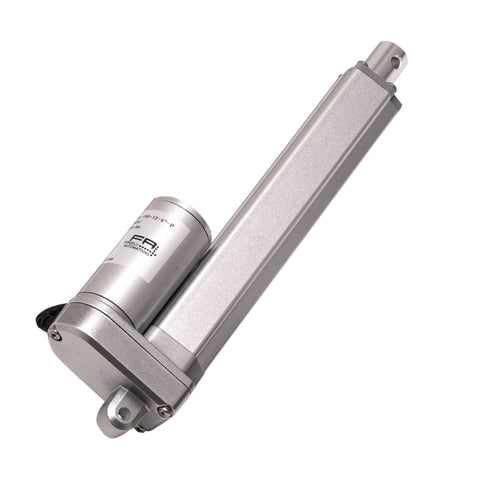Firgelli Automations sells several different types of electric linear actuators. This blog post will give a brief description of the different types and their typical uses.
Rod-Style Linear Actuators
Rod-style linear actuators are the most commonly seen actuators. The basic rod-style actuator consists of a motor, gearbox, lead screw, and a rod. The motor converts electrical energy into mechanical rotation. The gearbox then reduces the speed of the rotation but increases the torque. The gearbox is also used to pass the rotational motion onto the lead screw. Finally, as the lead screw rotates, the rod of the actuator moves outward along the lead screw creating the linear motion. The distance that the rod extends outwards from the body of the actuator is the stroke. With rod-style actuators, the motor is sometimes positioned parallel to the rod, like shown below, or it can be perpendicular to the rod, like with our deluxe rod actuators.
As rod-style linear actuators are so common, they are widely used in various applications and come with a wide range of stroke lengths and force ratings. You will also see additional features, like feedback, which will be discussed more below. Overall, rod-style linear actuators are ideal for a wide range of applications from industrial uses to DIY projects.
Bullet Series Linear Actuators
Our bullet series linear actuators are a unique version of a rod-style linear actuator that has the motor and gearbox in line with the rod and lead screw. This gives these actuators a longer but thinner profile as seen in the video below. This makes them ideal for narrow spaces where otherwise the motor may get in the way as well as giving the actuator an improved aesthetic.
Track Linear Actuators
Track linear actuators are like rod-style linear actuators as they consist of a motor, gearbox, and lead screw, but instead of a rod, these actuators use a sliding carriage. This sliding carriage moves along the track of the lead screw as it rotates giving these actuators their name. Because of this, the stroke of a track linear actuator is equal to the length of the lead screw. This means these actuators have a fixed length. It makes them easier to design around than rod-style linear actuators, but it also means they lack the telescopic motion that rod-style actuators have. Track actuators are also more vulnerable to debris as the lead screw is exposed to allow the sliding carriage to move along it. You can learn more about track linear actuators here.
Track linear actuators are ideal for sliding applications and are often used in custom cabinetry and with sliding doors. You may consider using a track linear actuator over a rod-style linear actuator in situations where you have movement along one axis and do not require telescopic motion.
Lifting Columns
Lifting columns, like the other electric linear actuators, convert electrical energy into linear motion and, like rod-style actuators, provide telescopic linear motion. They also consist of a motor, gearbox, and lead screw. However, instead of extending a rod, the lead screw moves out a column. Lifting columns usually have multiple stages that are used to split the extension length in half and allow the column to collapse into an even smaller profile. Lifting columns are designed to be used in a vertical upright orientation. While this is a bit of a limitation, it allows them to be designed sturdier than other types of electric linear actuators and to be installed without additional mounting brackets.
The design of these lifting columns makes them ideal for home automation and they are often used in standing desks and TV lifts. They can also be used in custom DIY applications, like in the pop-up wine cellar below.
Other Differing Factors
Within each type of electric linear actuator, you will be able to find various versions. They are usually differentiated by specifications like speed, stroke length, force rating, and voltage supply. There are also options to have feedback provided and the type of feedback as well as different IP ratings, which determines how well the enclosure protects the internal components from contaminants.
